Do you ever wonder how massive boulders end up in unexpected places or how entire landscapes are sculpted over time? How Do Rocks Move? Rocks move through a fascinating process called erosion, where forces like water, wind, ice, and gravity transport them across our planet, and at rockscapes.net, we can help you understand those forces and use the results to create something beautiful. Understanding these forces is crucial for appreciating the dynamic nature of our world and incorporating geological elements into your landscape designs. Discover the beauty of erosion, weathering, and sediment transport on rockscapes.net.
1. What Are the Primary Forces Behind Rock Movement?
The movement of rocks, or erosion, is influenced by several key natural forces that work in harmony to reshape the Earth’s surface.
The primary forces behind rock movement are water, wind, ice (glaciers), and gravity. These forces act on rocks, breaking them down and transporting them to new locations.
- Water: Water is a powerful erosional force, moving rocks through rainfall, waves, floods, and rivers. Rainfall picks up loose rocks, while waves erode shorelines. Floods and rivers move rocks by force.
- Wind: Wind can pick up small pieces of rock and carry them away, especially in arid and semi-arid regions.
- Glaciers: Glaciers are moving bodies of ice that cut into the earth, loosening rocks and pushing them to new places.
- Gravity: Gravity pulls materials towards the earth’s surface. Loose rocks at higher elevations can move down under the influence of gravity, causing landslides and rockfalls.
Understanding these forces can help you anticipate how rocks will behave in your landscape and design accordingly.
2. How Does Water Contribute to Rock Erosion and Movement?
Water is a dominant force in shaping the Earth’s surface and plays a significant role in the erosion and movement of rocks.
Water contributes to rock erosion and movement through rainfall, waves, floods, and rivers.
- Rainfall: As raindrops fall on the earth, they dislodge loose soil and small rock fragments. This runoff carries the materials downhill, contributing to soil erosion and the transport of sediments.
- Waves: Along coastlines, waves are a relentless force that erodes cliffs and shorelines. The constant crashing of waves breaks down rocks into smaller pieces, which are then carried away by the water.
- Floods: During floods, large volumes of water move rapidly across the land, picking up and carrying rocks, soil, and debris. The force of the water can dislodge even large boulders, moving them downstream.
- Rivers: Rivers act as conveyor belts, transporting rocks and sediments from higher elevations to lower areas. The flowing water erodes the riverbanks and bed, carrying the eroded material downstream.
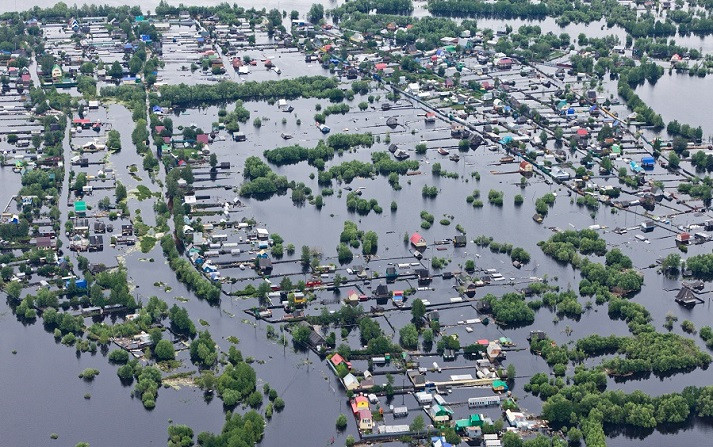 aerial view of flood
aerial view of flood
According to a study by the U.S. Geological Survey, rivers transport billions of tons of sediment to the oceans each year, significantly reshaping landscapes.
3. What Role Does Wind Play in Transporting Rocks?
Wind is an essential agent of erosion, particularly in arid and coastal regions, where it can effectively transport rocks.
Wind transports rocks by picking up small pieces of rock and carrying them away. This process, known as aeolian transport, is most effective in areas with little vegetation cover, where the wind can directly act on the surface material.
- Suspension: Fine particles, such as silt and clay, can be lifted into the air and carried long distances by the wind.
- Saltation: Sand-sized particles are too heavy to be suspended, so they move by bouncing or skipping along the surface.
- Creep: Larger particles, such as pebbles and small rocks, are moved by the impact of saltating grains, causing them to roll or slide along the surface.
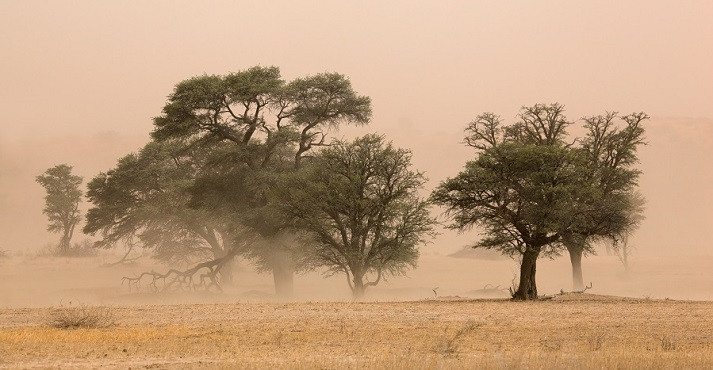 wind storm
wind storm
The Dust Bowl of the 1930s in the United States is a stark reminder of the power of wind erosion. Prolonged drought and poor farming practices led to extensive soil erosion, as wind storms carried away topsoil, devastating agricultural lands.
4. How Do Glaciers Contribute to the Movement of Rocks?
Glaciers, massive bodies of ice, are powerful agents of erosion and transportation, reshaping landscapes and moving rocks over considerable distances.
Glaciers contribute to the movement of rocks by cutting into the earth’s surface, loosening rocks, and pushing them to new places.
- Erosion: As glaciers move, they erode the underlying bedrock through abrasion and plucking. Abrasion occurs when the ice grinds against the rock surface, smoothing and polishing it. Plucking involves the glacier freezing onto rocks and then pulling them out as it moves.
- Transportation: Glaciers can carry rocks of all sizes, from small pebbles to massive boulders, embedded within the ice. These rocks are transported over long distances and deposited when the glacier melts.
- Deposition: When glaciers melt, they deposit the rocks and sediments they have been carrying, creating landforms such as moraines, eskers, and drumlins.
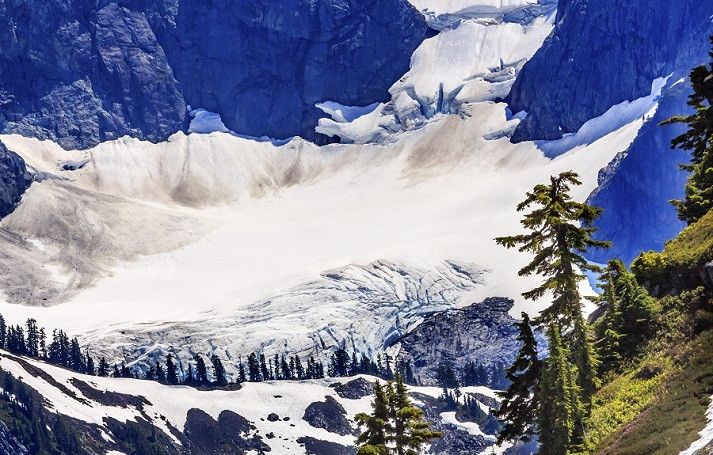 glacier
glacier
According to research from the University of Colorado’s Institute of Arctic and Alpine Research, glaciers have played a significant role in shaping the landscapes of mountainous regions worldwide, leaving behind unique geological features.
5. In What Ways Does Gravity Influence Rock Movement?
Gravity is a fundamental force that plays a crucial role in the movement of rocks and sediments on Earth’s surface.
Gravity influences rock movement by pulling materials towards the earth’s surface. When loose rocks are found at a higher elevation, they can move down under the influence of gravity.
- Rockfalls: Rockfalls occur when rocks detach from a cliff or steep slope and fall freely through the air.
- Landslides: Landslides involve the downslope movement of a mass of rock, soil, and debris.
- Mudflows: Mudflows are a type of landslide that consists of a mixture of water, soil, and rock fragments.
- Creep: Soil creep is the slow, gradual downslope movement of soil and rock particles.
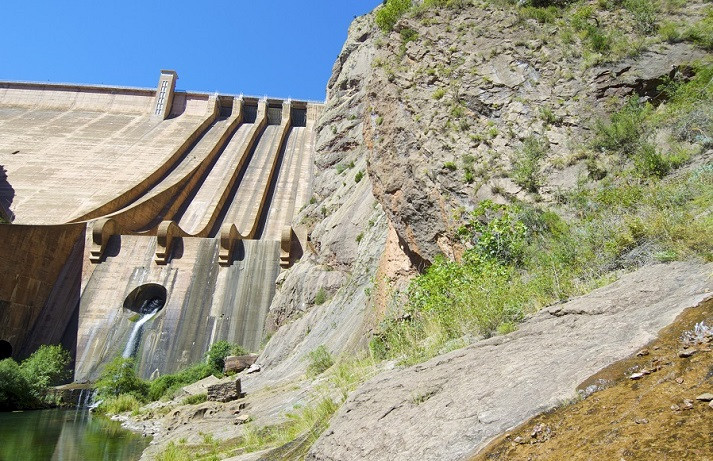 dam
dam
The U.S. Geological Survey estimates that landslides cause billions of dollars in damages and thousands of fatalities each year worldwide, highlighting the significant impact of gravity-driven rock movement.
6. How Does Weathering Prepare Rocks for Movement?
Weathering is the process of breaking down rocks into smaller pieces. Weathering weakens rocks, making them more susceptible to movement by erosion.
Weathering prepares rocks for movement by breaking them down into smaller pieces through physical and chemical processes.
- Physical Weathering: Physical weathering involves the mechanical breakdown of rocks into smaller pieces without changing their chemical composition.
- Freeze-Thaw: Water enters cracks in rocks, freezes, expands, and widens the cracks, eventually causing the rock to break apart.
- Thermal Expansion: Rocks expand when heated and contract when cooled. Repeated expansion and contraction can weaken the rock structure, leading to fracturing.
- Abrasion: Rocks are worn down by friction with other rocks or particles, such as sand or gravel.
- Chemical Weathering: Chemical weathering involves the alteration of the chemical composition of rocks, leading to their decomposition.
- Dissolution: Minerals in rocks dissolve in water, weakening the rock structure.
- Oxidation: Minerals react with oxygen, causing them to rust and crumble.
- Hydrolysis: Minerals react with water, forming new minerals and weakening the rock structure.
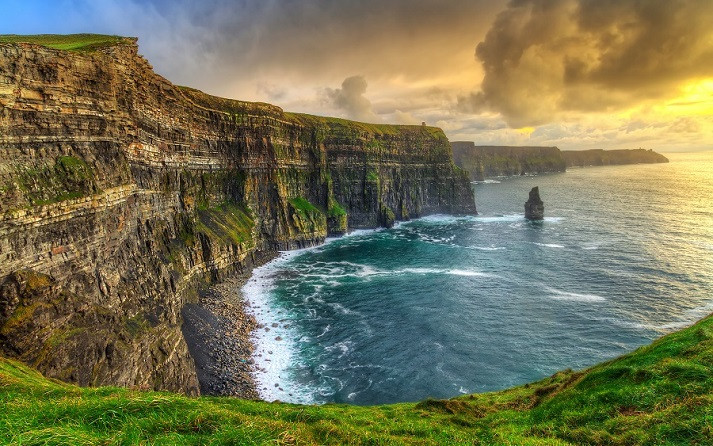 coastal cliff
coastal cliff
According to a study by the Geological Society of America, weathering rates vary depending on factors such as climate, rock type, and topography.
7. What Types of Rocks Are Most Susceptible to Movement?
The susceptibility of rocks to movement depends on their composition, structure, and the environmental conditions they are exposed to.
Rocks that are most susceptible to movement are sedimentary rocks, fractured rocks, and rocks exposed to high levels of weathering.
- Sedimentary Rocks: Sedimentary rocks, such as sandstone and shale, are often less resistant to weathering and erosion than igneous or metamorphic rocks. They are composed of cemented sediments, which can be easily broken apart by water, wind, or ice.
- Fractured Rocks: Rocks with fractures or joints are more susceptible to weathering and erosion because water and ice can penetrate the cracks, weakening the rock structure.
- Rocks Exposed to High Levels of Weathering: Rocks in areas with high rainfall, temperature fluctuations, or chemical weathering are more likely to break down and be transported by erosion.
However, a sedimentary rock like limestone, can resist the forces of erosion if it has enough of the mineral calcite, which is crystallized calcium carbonate.
8. How Does Vegetation Impact Rock Stability and Movement?
Vegetation plays a critical role in stabilizing soil and rocks, reducing the risk of erosion and landslides.
Vegetation impacts rock stability and movement by providing a protective cover, binding soil particles together, and intercepting rainfall.
- Protective Cover: Vegetation provides a protective cover that shields the soil and rocks from the direct impact of rainfall and wind, reducing erosion.
- Binding Soil Particles: Plant roots bind soil particles together, increasing the soil’s resistance to erosion. The roots act as anchors, holding the soil in place and preventing it from being washed or blown away.
- Intercepting Rainfall: Vegetation intercepts rainfall, reducing the amount of water that reaches the ground. This reduces the risk of runoff and soil erosion.
- Reducing Landslides: Vegetation can help stabilize slopes, reducing the risk of landslides. The roots of trees and shrubs can anchor the soil and rock, preventing them from sliding downhill.
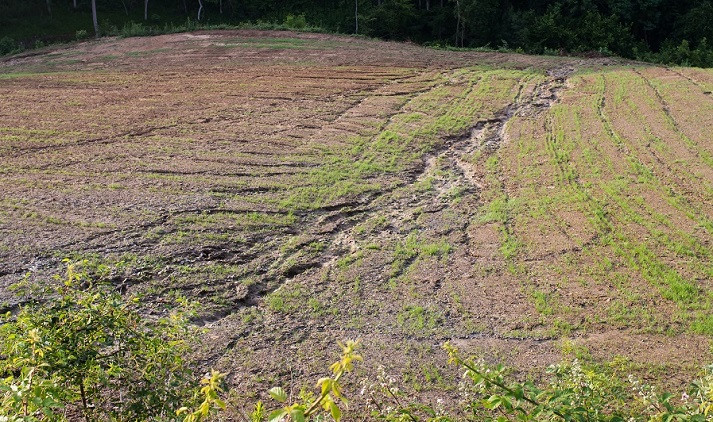 field
field
According to research from the USDA Natural Resources Conservation Service, vegetation can significantly reduce soil erosion rates, with well-vegetated areas experiencing much lower erosion rates than bare or sparsely vegetated areas.
9. What Are Some Examples of Landforms Created by Rock Movement?
The movement of rocks by erosion creates a variety of distinctive landforms that shape our planet’s surface.
Examples of landforms created by rock movement include canyons, valleys, cliffs, and coastal arches.
- Canyons: Canyons are deep, narrow valleys with steep sides, formed by the erosive power of rivers over millions of years.
- Valleys: Valleys are elongated depressions in the landscape, formed by the erosive action of rivers or glaciers.
- Cliffs: Cliffs are steep, vertical rock faces, formed by the erosion of coastal or mountainous areas.
- Coastal Arches: Coastal arches are natural arches formed by the erosion of sea cliffs by waves.
- Moraines: Moraines are accumulations of rock and sediment deposited by glaciers, forming ridges or mounds.
- Drumlins: Drumlins are elongated hills formed by the deposition of glacial sediments.
These landforms not only showcase the power of erosion but also provide unique habitats for plants and animals and can be stunning features in landscape designs.
10. How Can Humans Influence or Control Rock Movement?
Humans can influence or control rock movement through various activities, such as construction, mining, and land management practices.
Humans can influence or control rock movement through construction, mining, and land management practices.
- Construction: Construction activities, such as road building and building construction, can destabilize slopes and increase the risk of landslides.
- Mining: Mining activities can expose large areas of rock and soil, making them more susceptible to erosion.
- Land Management Practices: Land management practices, such as deforestation and agriculture, can also influence rock movement. Deforestation can remove the protective cover of vegetation, increasing soil erosion. Agriculture can deplete soil nutrients and weaken the soil structure, making it more susceptible to erosion.
- Mitigation Measures: Humans can also implement measures to control rock movement, such as building retaining walls, planting vegetation, and implementing erosion control measures.
By understanding the forces that move rocks and the factors that influence their stability, humans can take steps to minimize the risks associated with rock movement and protect infrastructure and property.
11. What Safety Precautions Should Be Taken Near Areas Prone to Rock Movement?
Safety is paramount in areas susceptible to rock movement, requiring proactive measures to mitigate risks.
Safety precautions that should be taken near areas prone to rock movement include avoiding building in hazardous areas, monitoring slopes for signs of instability, and installing protective measures.
- Avoid Building in Hazardous Areas: Avoid building homes or infrastructure in areas known to be prone to rockfalls, landslides, or other forms of rock movement.
- Monitor Slopes for Signs of Instability: Regularly monitor slopes for signs of instability, such as cracks, bulges, or leaning trees.
- Install Protective Measures: Install protective measures, such as retaining walls, rock fences, and debris flow barriers, to prevent rocks from falling onto roads, buildings, or other infrastructure.
- Emergency Plans: Develop emergency plans for responding to rockfalls or landslides, including evacuation routes and communication protocols.
- Public Awareness: Educate the public about the risks associated with rock movement and the safety precautions they should take.
Staying informed and prepared can significantly reduce the risks associated with rock movement in vulnerable areas.
12. How Does Rock Movement Affect Coastal Areas?
Rock movement has a profound impact on coastal areas, shaping shorelines and influencing coastal ecosystems.
Rock movement affects coastal areas through erosion of cliffs and shorelines, formation of beaches, and creation of coastal landforms.
- Erosion of Cliffs and Shorelines: Waves erode cliffs and shorelines, breaking down rocks into smaller pieces. This erosion can lead to the retreat of coastlines and the loss of valuable land.
- Formation of Beaches: The eroded material from cliffs and shorelines is transported by waves and currents, eventually depositing on beaches. Beaches provide habitat for a variety of marine organisms and protect coastlines from storm surge.
- Creation of Coastal Landforms: Rock movement can create a variety of coastal landforms, such as sea stacks, arches, and caves.
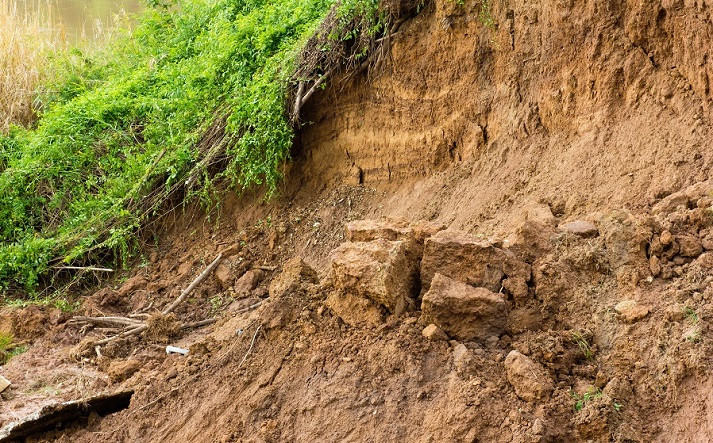 erosion
erosion
The California Coastal Commission estimates that coastal erosion threatens billions of dollars worth of property along the California coast, highlighting the significant economic impact of rock movement in coastal areas.
13. What Are the Environmental Impacts of Rock Movement?
Rock movement, while a natural process, can have significant environmental impacts, both positive and negative.
The environmental impacts of rock movement include soil erosion, water pollution, habitat destruction, and the release of minerals.
- Soil Erosion: Soil erosion can lead to the loss of fertile topsoil, reducing agricultural productivity and increasing the risk of desertification.
- Water Pollution: Rock movement can transport pollutants, such as heavy metals and pesticides, into water bodies, contaminating drinking water and harming aquatic life.
- Habitat Destruction: Rock movement can destroy habitats, displacing or killing plants and animals.
- Release of Minerals: Rock movement can release minerals into the environment, which can have both beneficial and harmful effects. For example, the release of phosphorus can enhance plant growth, while the release of arsenic can contaminate water and soil.
- Sedimentation: Excessive sediment deposition in rivers and lakes can disrupt aquatic ecosystems, impacting fish spawning and water quality.
Addressing these environmental impacts requires careful land management practices and mitigation strategies to minimize the negative consequences of rock movement.
14. How Can Rock Movement Be Used to Create Unique Landscape Designs?
Rock movement, despite its potential for destruction, can be harnessed to create stunning and unique landscape designs.
Rock movement can be used to create unique landscape designs by incorporating natural rock formations, creating rock gardens, and using rocks as building materials.
- Incorporating Natural Rock Formations: Natural rock formations, such as boulders, cliffs, and outcrops, can be incorporated into landscape designs to create a sense of drama and natural beauty.
- Creating Rock Gardens: Rock gardens can be created using a variety of rocks, gravel, and drought-tolerant plants. Rock gardens are a great way to showcase the beauty of rocks and create a low-maintenance landscape.
- Using Rocks as Building Materials: Rocks can be used as building materials for walls, patios, walkways, and other landscape features. Rocks add a natural, rustic look to landscapes and are durable and long-lasting.
- Water Features: Incorporating rocks into water features like waterfalls and streams can enhance their natural appeal and create soothing sounds.
- Erosion Control: Using rocks to create terraces and retaining walls can help control erosion and create visually interesting landscapes on sloped properties.
By creatively using rocks, landscape designers can create unique and sustainable landscapes that blend seamlessly with the natural environment.
15. What Are the Latest Trends in Using Rocks in Landscape Architecture?
Landscape architecture is constantly evolving, and the use of rocks is no exception. Several new trends are emerging that showcase the versatility and beauty of rocks in landscape design.
The latest trends in using rocks in landscape architecture include using native rocks, creating sustainable landscapes, and incorporating technology.
- Using Native Rocks: There is a growing trend towards using native rocks in landscape designs. Native rocks are those that are found naturally in the area and are well-suited to the local climate and soil conditions. Using native rocks helps to create landscapes that are more sustainable and that blend seamlessly with the natural environment.
- Creating Sustainable Landscapes: Landscape architects are increasingly focused on creating sustainable landscapes that minimize environmental impact. Rocks can be used to create sustainable landscapes by reducing the need for irrigation, providing habitat for wildlife, and controlling erosion.
- Incorporating Technology: Technology is also playing a role in the use of rocks in landscape architecture. For example, computer-aided design (CAD) software can be used to create complex rock formations, and 3D printing can be used to create custom rocks.
- Xeriscaping: Utilizing rocks in xeriscaping, a landscaping method that requires little or no irrigation, is gaining popularity in arid regions.
- Vertical Rock Gardens: Creating vertical rock gardens on walls or structures adds a unique and space-saving element to urban landscapes.
These trends reflect a growing appreciation for the natural beauty and sustainability of rocks in landscape design, as highlighted on rockscapes.net.
16. Where Can I Find High-Quality Rocks for My Landscaping Project in the USA?
Finding the right rocks for your landscaping project is essential to achieving the desired aesthetic and functionality.
You can find high-quality rocks for your landscaping project in the USA at local quarries, landscape supply stores, and online retailers.
- Local Quarries: Local quarries are a great source of natural rocks, such as boulders, flagstone, and gravel.
- Landscape Supply Stores: Landscape supply stores typically carry a wide variety of rocks, including decorative rocks, paving stones, and retaining wall blocks.
- Online Retailers: Online retailers offer a convenient way to shop for rocks, with a wide selection and competitive prices.
- Rockscapes.net: Rockscapes.net offers a wide selection of high-quality rocks for landscaping projects.
When choosing rocks, it is important to consider the type of rock, the size, the color, and the texture. It is also important to choose rocks that are appropriate for the climate and soil conditions in your area.
17. How Do I Choose the Right Size and Type of Rocks for My Project?
Selecting the appropriate size and type of rocks is crucial for achieving the desired look and functionality in your landscaping project.
To choose the right size and type of rocks for your project, consider the purpose of the rocks, the scale of the project, and the aesthetic you want to create.
- Purpose of the Rocks: Determine the primary function of the rocks in your landscape. Are they for creating a pathway, building a retaining wall, or simply adding decorative accents? Different purposes require different types and sizes of rocks.
- Scale of the Project: Consider the overall size of your landscaping project. Larger projects may require larger rocks to create a sense of scale and proportion. Smaller projects may benefit from smaller, more delicate rocks.
- Aesthetic: Think about the overall aesthetic you want to create in your landscape. Do you want a natural, rustic look or a more formal, polished look? Different types of rocks will create different effects.
- Rock Types: Common types include granite, limestone, sandstone, and slate, each offering unique colors, textures, and durability. Granite is excellent for structural elements, while limestone adds a softer, more weathered look.
- Size Considerations: Small pebbles are great for pathways and ground cover, medium-sized rocks work well for borders and accents, and large boulders can serve as focal points.
By considering these factors, you can choose the right size and type of rocks to create a beautiful and functional landscape.
18. What Are Some Common Mistakes to Avoid When Using Rocks in Landscaping?
Using rocks effectively in landscaping requires careful planning and execution. Avoiding common mistakes can help ensure a successful and visually appealing outcome.
Common mistakes to avoid when using rocks in landscaping include using too many rocks, using the wrong type of rocks, and not preparing the site properly.
- Using Too Many Rocks: Avoid using too many rocks in your landscape. Overusing rocks can make your landscape look cluttered and unnatural.
- Using the Wrong Type of Rocks: Use the right type of rocks for your landscape. Using the wrong type of rocks can make your landscape look out of place.
- Not Preparing the Site Properly: Prepare the site properly before installing rocks. Not preparing the site properly can lead to drainage problems and other issues.
- Ignoring Scale: Using rocks that are too small or too large for the space can create an unbalanced and unattractive landscape.
- Neglecting Maintenance: Rocks, like any other landscaping element, require maintenance. Neglecting to clean or reposition rocks can lead to a dull and unkempt appearance.
By avoiding these common mistakes, you can create a beautiful and functional landscape that showcases the natural beauty of rocks.
19. How Can I Ensure the Longevity and Stability of Rock Structures in My Landscape?
Ensuring the longevity and stability of rock structures in your landscape requires careful planning, proper construction techniques, and regular maintenance.
To ensure the longevity and stability of rock structures in your landscape, use proper construction techniques, provide adequate drainage, and maintain the structures regularly.
- Proper Construction Techniques: Use proper construction techniques when building rock structures. This includes using a strong foundation, interlocking the rocks properly, and using mortar or other binding agents as needed.
- Adequate Drainage: Provide adequate drainage for rock structures. This will help to prevent water from accumulating behind the structures, which can cause them to collapse.
- Regular Maintenance: Maintain rock structures regularly. This includes cleaning the rocks, repairing any cracks or damage, and removing any vegetation that is growing on the structures.
- Professional Assistance: For large or complex projects, consider hiring a professional landscaper or stonemason to ensure the job is done correctly.
By following these tips, you can ensure that your rock structures will remain stable and beautiful for many years to come.
20. What Resources Are Available to Learn More About Rock Movement and Landscaping?
Expanding your knowledge of rock movement and landscaping can enhance your ability to create stunning and sustainable landscapes.
Resources available to learn more about rock movement and landscaping include books, websites, and professional organizations.
- Books: There are many books available on rock movement and landscaping, covering topics such as geology, erosion, and landscape design.
- Websites: Many websites offer information on rock movement and landscaping, including government agencies, universities, and professional organizations.
- Professional Organizations: Professional organizations, such as the American Society of Landscape Architects (ASLA), offer educational resources and networking opportunities for landscape professionals.
- Local Nurseries: Visit local nurseries and garden centers to learn about rock types, planting techniques, and sustainable landscaping practices.
- Rockscapes.net: Rockscapes.net provides a wealth of information on rock types, landscape design ideas, and expert advice.
By utilizing these resources, you can expand your knowledge and create beautiful and sustainable landscapes that showcase the natural beauty of rocks.
Ready to explore the stunning possibilities of rockscapes? Visit rockscapes.net today for inspiration, expert advice, and the finest selection of rocks for your next landscaping masterpiece. Let us help you turn your vision into a breathtaking reality!
Address: 1151 S Forest Ave, Tempe, AZ 85281, United States. Phone: +1 (480) 965-9011. Website: rockscapes.net.
FAQ: Understanding Rock Movement
1. What is the main cause of rock movement?
The main causes of rock movement are water, wind, ice (glaciers), and gravity. These forces erode rocks and transport them.
2. How does water erode rocks?
Water erodes rocks through rainfall, waves, floods, and rivers, each contributing differently to the process.
3. Can wind really move rocks?
Yes, wind can move small rocks through a process called aeolian transport, particularly in arid areas.
4. How do glaciers affect rock movement?
Glaciers erode and transport rocks by cutting into the earth’s surface and pushing them along as they move.
5. What role does gravity play in moving rocks?
Gravity pulls loose rocks downhill, leading to rockfalls and landslides, which are significant forms of rock movement.
6. What is weathering, and how does it relate to rock movement?
Weathering is the breaking down of rocks into smaller pieces, preparing them for movement by erosion.
7. Are some types of rocks more easily moved than others?
Yes, sedimentary rocks and fractured rocks are generally more susceptible to movement due to their composition and structure.
8. How does vegetation prevent rock movement?
Vegetation stabilizes soil and rocks with its roots, reducing erosion and the risk of landslides.
9. What are some landforms created by rock movement?
Landforms created by rock movement include canyons, valleys, cliffs, and coastal arches.
10. How can humans control or influence rock movement?
Humans can control or influence rock movement through construction practices, land management, and mitigation measures.